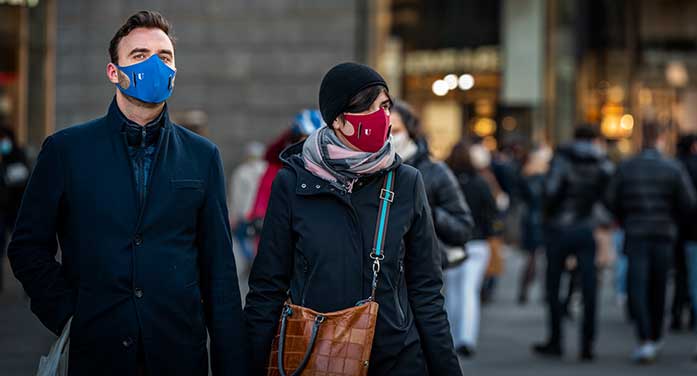 Since last September, experts have testified at a tribunal hearing for an Alberta chiropractor on how well masks do, or don’t, slow the spread of SARS-CoV-2, the virus that causes COVID-19.
Since last September, experts have testified at a tribunal hearing for an Alberta chiropractor on how well masks do, or don’t, slow the spread of SARS-CoV-2, the virus that causes COVID-19.
Unfortunately, the chiropractor’s college, YouTube and LinkedIn didn’t want you to know what was said because most of it contradicts what people have been told over the past two years.
Since mid-2020, the College of Chiropractors of Alberta has required its 1,100 chiropractors and their patients to wear masks. However, Calgary chiropractor Curtis Wall did not, as he had a medical exemption to not wear a mask because it caused him anxiety and a sense of claustrophobia.
Wall was accused of “unprofessional conduct” by his college, so he hired lawyer James Kitchen to represent him, first with his funds, then through Liberty Coalition Canada. Kitchen called four witnesses to the stand and the college called one. The college was unsuccessful in its request for a media ban on the testimony, though some names remain redacted.
The college’s witness was a physician who had a substantial influence on the pandemic response in Calgary and Alberta. His report to the tribunal claimed “there is an overwhelming body of evidence supporting the use of masking in health-care settings to reduce COVID transmission,” with “no known harms associated with masking.”
Under cross-examination, the doctor confirmed he wasn’t a virologist, immunologist, respirologist or microbiologist. He also admitted that for “people with extreme anxiety, [masks] can make you anxious.”
Enter Medicine Hat respirologist Bao Dang. He said SARS-CoV-1 had “a lot of similar properties” to the original SARS of 2004, and the only people masked then were sick patients. He believed the public was forced to be masked this time due to “a social and political aspect … causing mass paranoia and fear and panic” and that “firm evidence” of its effectiveness was lacking. He cited two academic reviews that showed there was no proof surgical masks stopped infection in operating rooms either, just blood and saliva.
Dang said N95 masks were designed to catch 95 per cent of materials that were 0.3 microns or bigger, but SARS-CoV-1 was 0.1 microns. He also cited the DANMASK-19 study, a randomized control trial of people in Denmark who wore masks to prevent COVID-19 and others who didn’t. “Despite desperately wanting to find objective evidence that masks [work], they could not,” Dang concluded.
“Having the public wear masks, most of which are often wet, dirty, reused and incorrectly worn, can lead to health problems and inhaling pollutions and secretions over and over,” Dang said.
In the opinion of occupational health and safety consultant Chris Schaefer, masking the public was “beyond strange” and “alarming.” He called public mask mandates “Russian roulette” and risky for those with COPD, heart conditions, lung conditions or high blood pressure. He said N95s were “breathing barriers,” unlike typical masks, and “were never designed for hour-upon-hour use.”
Schaefer teaches courses on fitting and testing respirators to people in the military, health-care fields, schools and private industry. He told the tribunal that workers are supposed to get individually fitted for a mask before wearing one, and if an individual had added risk factors, physicians had to assess whether the worker was okay to wear a respirator. But under COVID, he said, “there’s no screening anymore; it’s just wear one or else, and that’s never happened before.”
Occupational health and safety standards limited carbon particles to 1,000 parts per million and required oxygen levels to be 19.5 per cent or higher, Schaeffer said. Yet everyone he tested wearing an N95 mask for two minutes had too much carbon and too little oxygen. If the natural air was that bad, the regulations said a workplace had to be evacuated.
To mask or not to mask? by Michael Taube
It really comes down to your comfort level, belief system and what you want to do until instructed otherwise
Dr. Byram Bridle, a professor of viral immunology at the University of Guelph, told the tribunal that the survival rate for COVID at the end of 2020 was 99.85 per cent. He likened that to a “bad flu season” and said percentages under the later Omicron variant were even less deadly. Bridle said masking was only appropriate for the sick and not the asymptomatic. Unless someone was coughing and sneezing, they were unlikely to spread enough virus to infect anyone.
Wall’s fourth witness, a medical microbiologist and infectious disease specialist whose name was not released to the public, said, “the difference between symptomatic transmission and asymptomatic transmission was about 25 times.”
He also pointed to a “cluster-randomized trial” of over 300,000 people in Bangladesh. Here, villages where everyone wore a surgical mask had an infection rate of 0.67 per cent, and villages where everyone was unmasked had an infection rate of 0.76 per cent. At those rates, eight weeks of mask wearing by all of Alberta’s 1,100 chiropractors would only prevent one infection.
I tried to narrate these facts on a YouTube video, but it was yanked as misinformation. And when I posted an article on LinkedIn with this testimony, it promptly disappeared.
It’s time for the truth to be unmasked – and for people’s faces to follow.
Lee Harding is a research associate for the Frontier Centre for Public Policy.
Lee is a Troy Media Thought Leader. For interview requests, click here.
The opinions expressed by our columnists and contributors are theirs alone and do not inherently or expressly reflect the views of our publication.
© Troy Media
Troy Media is an editorial content provider to media outlets and its own hosted community news outlets across Canada.


Excellent article. I hope more people see it. Was the chiropractor exonerated?
Excellent article. I hope more people see it. Was the chiropractor exonerated?